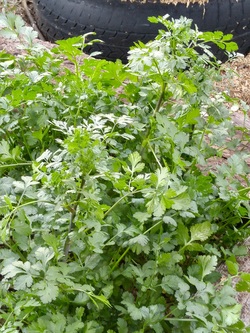
So here are some of the immediate issues that I see in my garden, and my suggestions for your garden:
Fruit Trees won’t gain any additional their chill hours, and they may blossom early. One of our Master Gardeners whose forte is fruit trees has determined that they’ve received sufficient chill time (hours of temperatures below 41°) to satisfy most low-chill varieties generally suitable for our area (about 300 hours).
If tree blossom buds begin swelling, be sure to finish whatever pruning you had in mind. Especially for beginners who aren’t really sure of where to cut, this “last chance” timing is perfect because it’s immediately apparent where the buds are and so easy to cut just above the outfacing bud in the direction that you want the new growth to go.
Broccoli and baby bok choy bolting (shoots lengthening and going to flower). This is always bound to happen when planted in Fall, since the merest heat in spring will shift their hormones to blossoming. And over 80 degrees for more than a week is more than “mere” heat! You can still make a point of harvesting the small florettes, and remember to eat them all – the whole flower stalk is tasty and usually sweeter than the buds themselves. Do sow more seed or transplant more seedlings now so you’ll be able to count on the new plants for longer harvests, perhaps even through June, after the current plants lessen their production of salvageable shoots. (Later in the season, when the lettuce bolts, you’ll find that the leaves on the bolted stalks turn inedibly bitter, so always taste a leaf of each variety before picking a lot.)
Water deeply now so roots have residual moisture to pull from the soil for the rest of the week while the heat persists. Like when you’re about to go out on a run or long walk, it’s best to hydrate yourself well before exercising so your body can be fully supplied – much healthier than trying to fill up with water after you’re returned from exercising and have stressed your body because it didn’t have enough water available.
Watering now is the beginning of teaching new plants to grow their roots deeply to reach the water in the soil. Make a point of watering deeply so moisture reaches at least six inches below the bottom-most roots for the particular type of plant. For example, lettuce roots will extend to six inches deep, so you should water to moisten soil a foot deep. You can zone your plants to be complementary – like planting lettuce and squash or tomatoes together – so you water for the deep-rooted plants and automatically supply the shallow-rooted plants. Or, you can plant all shallow-rooted plants in one area, and all deeper-rooted plants in another.
Purchasing a moisture meter will help beginners to determine how deep water is applied until they develop their own “feel” for the process. The $10 cost will be paid back shortly because plants are provided with the appropriate amount of water, and plants will be healthier because they’re receiving the amount of water they need. Best of both worlds, and accurate because there’s no guessing!
On the positive end of this early heat, sow seeds of the first of your summer vegetable choices, and plant seedlings you purchase. We don’t know what the immediate weather future will be, so may as well get a jump on summer-lovers. Even if it turns cold again, you’ll just replant them later anyway! Best to start seeds in starter trays, instead of the garden soil, since the soil is still too cold for healthy germination, unless you have a bed with lots of organic matter that warms up quickly.
Seed-starting temperature guidelines for warm-season vegetables are 65-80°F. Or, try the “seat” or “palm” test – set your bare skin on the soil; if it feels comfortable, it’s warm enough to start seeds; if it feels chilly, it’s not yet warm enough.
Definitely a good thing – It was 5:45pm this evening before I couldn’t tell the difference between the weeds and the wildflowers, so had to come indoors to make dinner – using those blossomy shoots of broccoli and bok choy along with other greens, of course!




 RSS Feed
RSS Feed